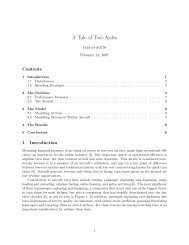Neural Models of Bayesian Belief Propagation Rajesh ... - Washington
Neural Models of Bayesian Belief Propagation Rajesh ... - Washington
Neural Models of Bayesian Belief Propagation Rajesh ... - Washington
You also want an ePaper? Increase the reach of your titles
YUMPU automatically turns print PDFs into web optimized ePapers that Google loves.
254 11 <strong>Neural</strong> <strong>Models</strong> <strong>of</strong> <strong>Bayesian</strong> <strong>Belief</strong> <strong>Propagation</strong> <strong>Rajesh</strong> P. N. Rao<br />
where ri is the normalized response (firing rate) and bi the implicit basis function<br />
associated with neuron i in the population. The basis function <strong>of</strong> each<br />
neuron is assumed to be linearly related to the tuning function <strong>of</strong> the neuron as<br />
measured in physiological experiments. The basis function approach is similar<br />
to the approach described in this chapter in that the stimulus space is spanned<br />
by a limited number <strong>of</strong> neurons with preferred stimuli or state vectors. The<br />
two approaches differ in how probability distributions are represented by neural<br />
responses, one using an additive method and the other using a logarithmic<br />
transformation either in the firing rate representation (sections 11.3.1 and<br />
11.3.2) or in the membrane potential representation (section 11.3.3).<br />
A limitation <strong>of</strong> the basis function approach is that due to its additive nature,<br />
it cannot represent distributions that are sharper than the component distributions.<br />
A second class <strong>of</strong> models addresses this problem using a generative<br />
approach, where an encoding model (e.g., Poisson) is first assumed and<br />
a <strong>Bayesian</strong> decoding model is used to estimate the stimulus x (or its distribution),<br />
given a set <strong>of</strong> responses ri [28, 46, 48, 49, 51]. For example, in the distributional<br />
population coding (DPC) method [48, 49], the responses are assumed to<br />
depend on general distributions P (x) and a maximimum a posteriori (MAP)<br />
probability distribution over possible distributions over x is computed. The<br />
best estimate in this method is not a single value <strong>of</strong> x but an entire distribution<br />
over x, which is assumed to be represented by the neural population. The<br />
underlying goal <strong>of</strong> representing entire distributions within neural populations<br />
is common to both the DPC approach and the models presented in this chapter.<br />
However, the approaches differ in how they achieve this goal: the DPC<br />
method assumes prespecified tuning functions for the neurons and a sophisticated,<br />
non-neural decoding operation, whereas the method introduced in this<br />
chapter directly instantiates a probabilistic generative model with an exponential<br />
or linear decoding operation. Sahani and Dayan have recently extended<br />
the DPC method to the case where there is uncertainty as well as simultaneous<br />
multiple stimuli present in the input [38]. Their approach, known as doubly<br />
distributional population coding (DDPC), is based on encoding probability<br />
distributions over a function m(x) <strong>of</strong> the input x rather than distributions over<br />
x itself. Needless to say, the greater representational capacity <strong>of</strong> this method<br />
comes at the expense <strong>of</strong> more complex encoding and decoding schemes.<br />
The distributional coding models discussed above were geared primarily toward<br />
representing probability distributions. More recent work by Zemel and<br />
colleagues [50] has explored how distributional codes could be used for inference<br />
as well. In their approach, a recurrent network <strong>of</strong> leaky integrate-andfire<br />
neurons is trained to capture the probabilistic dynamics <strong>of</strong> a hidden variable<br />
X(t) by minimizing the Kullback-Leibler (KL) divergence between an input<br />
encoding distribution P (X(t)|R(t)) and an output decoding distribution<br />
Q(X(t)|S(t)), where R(t) and S(t) are the input and output spike trains respectively.<br />
The advantage <strong>of</strong> this approach over the models presented in this<br />
chapter is that the decoding process may allow a higher-fidelity representation<br />
<strong>of</strong> the output distribution than the direct representational scheme used in this<br />
chapter. On the other hand, since the probability representation is implicit in
















